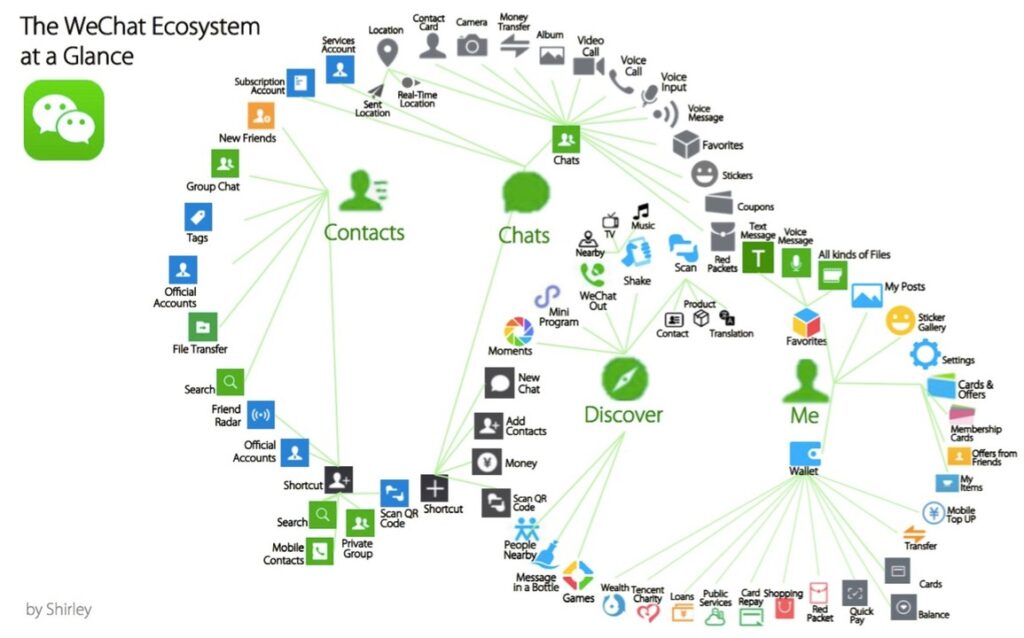In today’s digitally driven retail landscape, the ability to create meaningful and personalized customer experiences is more important than ever. As the retail environment evolves, brands must not only meet but exceed customer expectations to build loyalty and drive repeat business.
In this context, WeChat Customer Experience in Retail has emerged as a powerful platform that enables retailers to connect with their customers on a deeper, more personalized level through effective customer engagement strategies.
WeChat, initially launched as a simple messaging app, has transformed into a multifaceted ecosystem that integrates social media, e-commerce, mobile payments, and more. It is an essential tool for businesses, particularly in China, where it serves as a cornerstone for digital customer engagement.
The platform’s versatility allows retailers to create seamless, personalized interactions that not only enhance customer satisfaction but also foster long-term loyalty.
The integration of WeChat into customer experience strategies is no longer a luxury but a necessity. As businesses strive to differentiate themselves in a competitive market, leveraging WeChat’s capabilities can be a game-changer.
This article delves into the transformative power of WeChat in the retail sector, offering insights and practical strategies for businesses looking to enhance their customer experience and engagement through this dynamic platform.
Key Takeaways
Personalization and Targeting: WeChat offers an array of tools that enable retailers to deliver highly personalized content and offers to their customers by leveraging customer insights. By utilizing features such as Mini Programs and Official Accounts, businesses can gain valuable insights into customer behavior and preferences, allowing them to tailor their offerings more effectively. Personalization not only improves customer satisfaction but also strengthens brand loyalty.
Mapping the Customer Journey: Understanding the customer journey on WeChat is crucial for optimizing customer interactions. By mapping out the various touchpoints where customers engage with your brand, retailers can identify opportunities to enhance the customer experience. This strategic approach leads to more relevant and timely interactions, ultimately improving customer satisfaction and fostering stronger brand advocacy.
Social Listening and Feedback Management: In the digital age, customer feedback is a goldmine of insights that can drive business improvements. WeChat’s social listening capabilities allow businesses to monitor online conversations and feedback, providing real-time insights into customer needs and preferences. By effectively managing and responding to this feedback, retailers can improve their service offerings, build trust, and strengthen customer relationships.
Customer Retention and Lifetime Value: Building long-term relationships with customers is key to increasing customer lifetime value (CLV). WeChat provides the tools necessary to nurture these relationships through personalized marketing, loyalty programs, and engaging content. By focusing on retention, retailers can ensure continued customer satisfaction and repeat business, which are critical components of long-term success.
Leveraging Smart Retail Technologies: The integration of smart retail technologies with WeChat, such as mobile payments and augmented reality, further enhances the customer experience. These technologies enable more immersive and interactive shopping experiences, providing customers with a seamless blend of online and offline engagement. This approach not only meets the evolving expectations of modern consumers but also sets the stage for future innovations in retail.
Introduction to WeChat and Customer Experience
WeChat has become a staple in the daily lives of people from China and beyond. Customer satisfaction is crucial in the context of WeChat, as it directly impacts user retention and loyalty. Customer feedback on WeChat helps in refining customer engagement strategies.
The customer experience is a growing priority for both practice and research. Customer experience research examines various factors that influence the customer experience in retail settings, such as customer demographics, trading behaviors, and technology. WeChat also plays a significant role in customer retention by providing personalized and seamless interactions.
WeChat’s features, such as its mobile-payment systems, play a significant role in making customer experience management more effective by enhancing customer interactions through smart retail technologies. In smart retail settings, the integration of digital technologies like mobile augmented reality creates immersive, engaging environments that transform traditional shopping experiences. The concept of “customer experience” was first introduced in 1982 by Hobrook and Hirschman.
The customer experience is a key differentiator for retail firms, and effective customer engagement strategies are essential for success.
The Rise of WeChat in Retail
Businesses can leverage WeChat’s diverse set of tools and features to enhance customer engagement and foster brand allegiance. WeChat tools and features significantly contribute to customer satisfaction by providing personalized services and seamless interactions. Smart retail technologies contribute to the rise of WeChat in retail by enhancing customer insights and enabling more effective communication strategies.
Customer feedback collected through WeChat tools can be used to improve customer satisfaction.
Smart retail settings create immersive and engaging environments that enhance the customer experience, making WeChat an integral part of modern retail. Optimizing a WeChat Official Account is crucial for effective customer engagement and marketing strategies.
These tools and features help maintain customer loyalty by providing personalized promotions and seamless transactions, ultimately creating a strong relationship with customers that encourages repeat business. WeChat’s personalized services also contribute to customer retention.
Businesses can use WeChat to create a seamless, personalized, and engaging experience for customers.
By implementing these tips, businesses can keep customers returning for more.
WeChat has become a staple in the daily lives of people from China and beyond.
Understanding WeChat’s Ecosystem

WeChat 101: Key Features and Functions
WeChat is a multifaceted platform that transcends traditional messaging apps. Its features significantly contribute to customer satisfaction.
Understanding WeChat’s key features and functions is essential for both personal and business users, as they play a crucial role in customer engagement strategies and provide valuable customer insights. Customer feedback collected through WeChat can be used to enhance customer engagement strategies.
WeChat offers a range of features, including messaging, Moments, Official Accounts, Mini Programs, Payments, and more. Smart retail technologies, such as mobile payment systems and interactive displays, enable retailers to gather customer data and deliver personalized marketing messages.
Transaction and survey data collected from WeChat m-payment retail customers is used to analyze the impact of mobile-payment-based smart technologies on customer experiences and relationship quality within retail environments. Additionally, WeChat’s features aid in customer retention by providing personalized experiences based on customer feedback.
Enhancing Smart Retail Customer Experience

Mapping the Customer Journey on WeChat
Creating a visual representation of a customer’s progression as they engage with your brand on WeChat is essential for understanding their interaction journey. Mapping the customer journey by leveraging customer insights and focusing on customer perceived relationship orientation can lead to higher customer satisfaction. Customer feedback can be used to optimize the customer journey.
Smart retail technologies play a role in this mapping by providing data and insights that enhance customer insights and communication strategies, ultimately improving the retail customer experience. Ensuring a favorable online customer experience is critical in the context of digital transformation and changing customer behavior.
Recognize the points of interaction where customers connect with your brand, comprehend their actions and desires at every phase, and enhance their overall experience.
By focusing on customer perceived relationship orientation and effective customer engagement strategies, you can enhance the interaction between customers and social-technical touchpoints, significantly improving relationship quality and overall customer experience. Mapping the customer journey can lead to higher customer retention.
Personalization and Targeting
Tailoring marketing materials and messages to cater to the unique preferences, behaviors, and characteristics of individuals or specific groups is known as personalized marketing and targeting. Personalization and targeting can lead to higher customer satisfaction by addressing individual needs and preferences more effectively. Personalized marketing also provides valuable customer insights by making customers feel valued and understood.
Smart retail settings contribute to personalization and targeting by leveraging technologies like mobile augmented reality to create immersive, engaging environments that enhance customer interaction and personalization. Smart retail technologies (SRTs) improve customer insights and communication strategies, enabling more effective and tailored approaches based on customer data, ultimately driving better customer experiences and engagement.
Effective personalization strategies also contribute to customer retention by fostering loyalty and repeat business. Employee-customer interaction is also crucial, as technology adoption reshapes these interactions and significantly impacts the overall customer experience. By leveraging smart retail technology, such as mobile payments and interactive displays, along with cookies, machine learning algorithms, and customer relationship management (CRM) systems, businesses can create highly personalized experiences across various channels, incorporating effective customer engagement strategies.
Content Strategy for Engagement

Creating Compelling Visual Content
Creating visually appealing content is vital for impacting WeChat Moments and Stories. Creating compelling visual content with mixed reality technologies can provide valuable customer insights. Mixed reality technologies, including virtual and augmented reality, and smart retail technologies can significantly enhance visual content and improve customer satisfaction by transforming how customers interact with brands. Smart retail technologies also improve customer insights and communication strategies, allowing for more tailored and effective marketing communication. Crafting captivating visual material enables you to captivate your audience’s interest and promote interaction with your brand using successful customer engagement approaches. Engaging visual content can also contribute to customer retention.
Social Listening and Feedback Management
Monitoring Customer Feedback on WeChat
Social listening monitors online conversations and feedback about your brand, industry, or competitors. Monitoring customer feedback to gain customer insights can lead to higher customer satisfaction. Effective feedback management, facilitated by smart retail technologies, is crucial for creating a positive customer experience, as it helps businesses understand and address customer needs promptly on platforms like WeChat. Implementing robust customer engagement strategies can further enhance this process. Effective feedback management contributes to customer retention.
Crafting attention-grabbing visual content allows you to seize the interest of your audience and drive meaningful interaction with your brand using effective customer engagement strategies.
Responding to Customer Feedback
Responding to customer feedback is essential for building trust and customer loyalty with your customers. Addressing customer needs through feedback can lead to higher customer satisfaction and is a key part of customer engagement strategies. Responding to feedback leads to higher customer satisfaction.
Smart retail settings contribute to prompt and effective responses to customer feedback by integrating advanced technologies that enhance the customer experience. By utilizing smart retail technologies, such as mobile payments and interactive displays, you can improve customer insights and customer engagement strategies, allowing you to respond promptly and effectively to customer feedback, showing that you value their opinions and care about their experiences. Effective feedback management also contributes to customer retention.
Building Customer Lifetime Value
Strategies for Increasing Customer Lifetime Value
Customer lifetime value is a key metric for retailers, and is influenced by factors such as customer retention, customer acquisition, and customer profitability. Customer acquisition plays a crucial role in determining the overall customer lifetime value by providing valuable customer insights. Personalized marketing leads to higher customer satisfaction.
By implementing strategies such as loyalty programs, personalized marketing, excellent customer service, and leveraging smart retail technologies to enhance customer insights and customer engagement strategies, businesses can increase customer lifetime value. Effective customer engagement strategies contribute to customer retention.
Measuring Customer Lifetime Value
Measuring customer profitability and customer lifetime value involves calculating the total value of a customer to a business over their lifetime. Measuring customer lifetime value provides valuable customer insights. Understanding and measuring customer lifetime value leads to higher customer satisfaction.
Smart retail settings contribute to more accurate measurement of customer lifetime value by integrating mobile augmented reality and other digital technologies to enhance customer experiences. Effective measurement strategies also contribute to improved customer retention.
Implementing Effective Customer Service

Overcoming Market Saturation
Market saturation refers to a situation where a market has become saturated with similar products or services. Overcoming market saturation can provide valuable customer insights, as businesses that stand out can better meet customer needs and preferences, leading to higher customer satisfaction.
By implementing effective customer service and leveraging smart retail technologies, such as mobile payments and interactive displays, businesses can differentiate themselves from competitors and attract and retain customers. Effective customer service strategies also contribute to customer retention, ensuring long-term business success.
In smart retail settings, the integration of mobile augmented reality and other digital technologies creates immersive, engaging environments that enhance customer interaction and personalization, transforming traditional shopping experiences into innovative, tech-driven engagements. Smart retail technologies also improve customer insights and enable more effective customer engagement strategies, driving better customer experiences and engagement
Conclusion and Future Directions
The Future of WeChat in Retail
WeChat is expected to continue playing a significant role in the retail industry. The future of WeChat in retail will provide valuable customer insights through advanced communication strategies, enhancing customer satisfaction. Future advancements in WeChat will further enhance customer engagement strategies.
As technology advances, smart retail technologies will shape the future of WeChat in retail, enhancing customer insights and enabling more effective communication strategies. This will make WeChat even more integrated into daily life and offer new opportunities for businesses to engage with customers through improved customer engagement strategies. Effective customer engagement strategies will also contribute to higher customer retention.
Final Thoughts and Recommendations
Building a meaningful customer experience and relationship is critical to success in today’s competitive market. Final thoughts and recommendations on customer engagement strategies will lead to higher customer satisfaction. Effective customer engagement strategies contribute to customer retention.
Smart retail technologies contribute to this by improving customer insights and communication strategies, integrating technologies like mobile augmented reality to create immersive and engaging environments. Building a meaningful customer experience leads to higher customer satisfaction.
By leveraging WeChat’s features and functions, businesses can create a seamless, personalized, and engaging experience for customers, enhancing their customer engagement strategies.
To Learn more, you can enrol to Off-Grid Customer Experience Courses titled “Create a Digital Customer Experience Using WeChat“
FAQ’s about WeChat and Retail Customer Experience
What makes WeChat an essential tool for retail customer experience?
WeChat offers a comprehensive suite of tools, including messaging, mobile payments, and Mini Programs, that allow retailers to create personalized, seamless, and engaging experiences for their customers.
How can retailers use WeChat to personalize customer experiences?
Retailers can leverage WeChat’s features, such as targeted messaging, personalized promotions, and interactive content, to tailor experiences that meet individual customer preferences and needs.
What role does customer journey mapping play in enhancing WeChat customer experience?
What makes WeChat an essential tool for retail customer experience?
WeChat offers a comprehensive suite of tools, including messaging, mobile payments, and Mini Programs, that allow retailers to create personalized, seamless, and engaging experiences for their customers.
How can retailers use WeChat to personalize customer experiences?
Retailers can leverage WeChat’s features, such as targeted messaging, personalized promotions, and interactive content, to tailor experiences that meet individual customer preferences and needs.
What role does customer journey mapping play in enhancing WeChat customer experience?
Mapping the customer journey on WeChat helps retailers identify key engagement points, optimize user interactions, and deliver more relevant and timely content, leading to improved customer satisfaction.
Why is social listening important on WeChat, and how can it be implemented?
Social listening on WeChat allows businesses to monitor customer feedback, understand their needs, and respond promptly. Implementing social listening involves using WeChat’s analytics tools to track conversations and feedback, enabling businesses to adjust their strategies accordingly.
How can WeChat be used to increase customer lifetime value (CLV) in retail?
By offering personalized services, loyalty programs, and engaging content through WeChat, retailers can strengthen customer relationships, encourage repeat purchases, and ultimately increase CLV.
What makes WeChat an essential tool for retail customer experience?
WeChat offers a comprehensive suite of tools, including messaging, mobile payments, and Mini Programs, that allow retailers to create personalized, seamless, and engaging experiences for their customers. Additionally, WeChat provides valuable customer insights that help retailers understand their audience better and tailor their strategies accordingly.
Author
-

As a seasoned Content and Product Strategist, Benjamin leverages a unique blend of creativity and analytical prowess to craft compelling articles. With a passion for delivering impactful content experiences, he specializes in guiding brands towards strategic success through thoughtful planning and meticulous execution. Armed with a keen understanding of consumer behaviour and market trends, he drives engagement and fosters meaningful connections between audiences and brands.
View all posts




